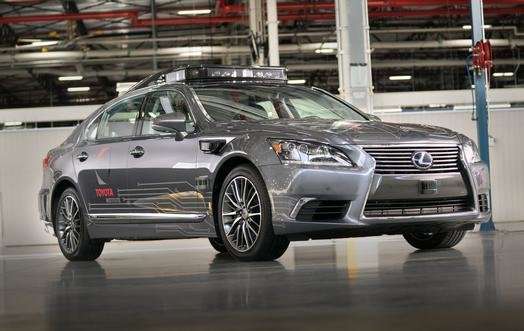January 6, 2018 weblog
Toyota 3.0 vehicle talking points: Augmented LIDAR, sleek design

Toyota is talking up what will be the third iteration of its autonomous research vehicle.
On Thursday the Toyota Research Institute (TRI) announced its Platform 3.0, namely its effort to showcase next-generation automated driving.
TRI is a subsidiary of Toyota Motor North America. The platform is built on a Lexus LS 600hL.
Ryan Eustice, TRI vice president of autonomous driving, was featured in the video promoting the announcement. He spoke about what they were trying to accomplish in the new platform.
"We had a couple of goals in mind," he said. They wanted to increase the sensing capabilities of the vehicle, improve the vehicle's styling, and go to scale to be able to build a fleet of these vehicles.
Much of the discussion in car-watching sites focused on the new platform's LIDAR (Light Detection and Ranging) features.
In brief, "TRI's Platform 3.0 boasts a more powerful Luminar lidar array," said Andrew Krok, CNET. "Whereas Platform 2.0's lidar only looked ahead, it now scans around the entirety of the vehicle at distances up to 200 meters."
Sven Gustafson, Autoblog: "It gets a Luminar LIDAR system boasting a 200-meter, 360-degree range (the previous version only tracked the forward direction), enabled by four high-res LIDAR scanning heads that help it better see dark objects."
He noted the shorter-range LIDAR sensors featured low on the car's four sides. There is one on each front quarter panel. They are also on front and rear bumpers, to detect low-level and smaller objects, like children or road debris.
Another talking point is design. Calty Design Research had a hand in the design. Toyota's 3.0 challenge was to avoid sacrificing sleek design looks to accommodate all the components. As one observer put it, it was all about taking those sensors and pushing them into the body—and still have the vehicle look "clean," as in sleek.)
TRI enlisted CALTY Design Research in Ann Arbor, Michigan as part of the effort. They wanted to compact and conceal sensors and camera.
Gustafson in Autoblog said the 3.0 autonomous test car was "notable for incorporating the sensors and cameras into the body, rather than as ungainly attachments, and with the spinning LIDAR rooftop sensor replaced by a more sleek panel of sensors.
It was similarly clear to Krok at CNET that "Toyota spent a lot of time repackaging sensors to hide as much of the hardware under body panels."
The company release credited the designer team's ingenuity for eliminating a look of equipment as bolt-on appendages—and replacing the spinning-bucket LIDAR sensor of autonomous test vehicles. Andrew Krok remarked that "the top-mounted sensor array now more closely resembles a Thule roof box than it does a series of lidar emitters and cameras."
Production of the 3.0 begins this spring. The Prototype Development Center in Michigan has expertise in low volume, specialized production, and a team will create Platform 3.0 cars from stock Lexus LS models.
The TRI news release said a share of these vehicles will have a dual cockpit control layout, a Guardian approach, while the other approach is tagged Chauffeur, which is TRI's approach to full vehicle automation. Both Guardian and Chauffeur test vehicles use the same stack of sensors and cameras and similar software.
TRI will bring the 3.0 vehicle to CES 2018 in Las Vegas.
© 2018 Tech Xplore



















